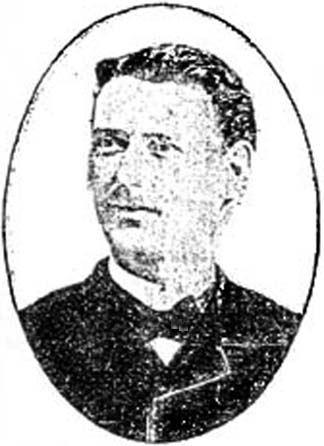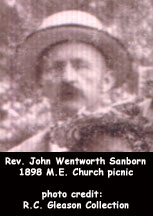Prominent
Minister, Author, Historian, and Lecturer Dead
John Wentworth Sanborn was a well-known lecturer
on on Indian lore and history. Lectured in London. Conducted exhibit at
Worlds Fair. Resident of this place for many years. Town historian. Preached
in local church six years.
Friendship N. Y., October 19,1922
 John Wentworth Sanborn,
AM., was born November third, 1848, at Eppiny, New Hampshire, son of Jeremiah
and olive Sanborn, was directly descended from the house of Stuarts, England,
his uncle, Governor Benj. Prescott was twice Governor of Massachusetts.
Mr. Sanborn was a graduate of Wesleyan University and Phillips Exeter
Academy. He had the degree of A. M., conferred upon him by Dartmouth College.
He was principal of Kingston academy and also principal of South Newmarket
(now Newfields), N. H., High School, editor of The Silver Lake Herald,
and for two years had studied law, but his convictions led him to the
ministry.
In the fall of 1873, he entered the Western
New York Conference (now called the Genesee Conference), in his twenty-fifth
year, and for thirty-five years he was in active service. His pastorates
were Perry, Gowanda, Batavia, Albion, Lockport, Naples, Smethport, Pa.,
Olean, Franklinville, and Friendship. The last pastorate he held for six
years. He was a good pastor, a true friend a genial brother, an indulgent
father and a devoted husband.
His life was like a book –well written and complete, full of sunshine,
with a tinge of shadow sometimes, which soon, like the closing of a book,
the shadows fled, the sunshine found abode in his soul, his trust in the
Promises were unshaken.
While he was a pastor in Gowanda, N.Y., he also made missionary to the
Indians on the Reservation close to Gowanda, learning the Seneca language
and preaching to them the simple story of God and His great love for us
all. While there he compiled a hymnal for them in the Seneca tongue, translating
our psalms and hymns to be used by them. He and his wife bound the books
and presented to them. The special type was made by him, he set it himself
and did the press work. The Indians were so delighted with the gift that
they at once made him an adopted son of the Wolf Clan—the largest
Clan among the Senecas—giving him the appellation of “O-yo-ga-weh-“,
meaning "Clear Sky" or" Sky Without a Cloud", thus
conferring upon him their highest evidence of gratitude.
He was appointed by Senator Donald McNaughton as Commissioner of Indians
Affairs at the World’s Fair in Chicago, Ill., and Director in Chief
of the New York State India Exhibit—the Conference giving permission
by a supernumerary relation for a time.
He has written many books and booklets on the North American Indian, and
possessed a large and rare collection of curies. These are now in the
New York State Museum at Albany, where they will be both interesting and
instructive and do much good.
His Greek and Latin text books have been published and used in schools
and colleges, especially has the compilation on Roots and Items of the
Latin Language. Many beautiful poems were penned by him—among the
best known are “The Man Behind the Gun” “Hunter Spare
That Bird,” “When my Ship behind The Pastor,” “The
Prayer Meeting Bell,” “The Man Behind the Plow,” “Our
Debt of Gratitude,” and many others.
Mr. Sanborn was connected with many societies: The Odd Fellows of Batavia,
N.Y., the A.O.U.W. of Batavia, N.Y., the Stratford-Shakespeare Circle
of Olean, The Olean Ministerial Club, the historical Club of Friendship,
N. Y., Literary Society of Scottsville, N.Y., Buffalo Historical Society,
buffalo society of National Sciences, Oneida historical Society of Utica,
N.Y., The British Association for the Advancement of Science, Manchester,
England, The British Folklore Society of Manchester, Eng., Fellow of the
American Association for the Advancement of Science New York City, Fellow
of the Paris Association for the Advancement of Research, Secretary and
Treasurer of the Silver Lake Assembly, and many minor organizations.
He was married to Adelaide Hiscox in 1886, of Brooklyn, N.Y., later of
Clifton Springs, N.Y. Four children were born to them, Arthur, Olive,
Ralph, and Harold. All arrived by Ralph, who died in the Hospital with
the flu there three years ago. One daughter, Mrs. Frank Faplin of Massachusetts,
by a former marriage, also survives him.
Two years ago Mr. Sanborn suffered a stroke, from which he never regained
his mentality or his bodily vigor, yet was able to be about and enjoy
the visits from friends. Two weeks ago he had a general breaking down
of the organs. He was more feeble, but he sat up and was and read his
papers, and the family was encouraged. But suddenly came a shock, the
second one. It passed. He was up in his chair before he died. That night
he was taken suddenly, and the end came at 10’o'clock Saturday evening,
October 14, 1922. His crossing the “Great Divide” was without
a struggle and a feeling came over us that the race had been run—the
victory won.
“By ways not understood.
Out of each dark vicissitude
God brings us compensating good.
For faith is perfected by fears
And souls renew their youth with years
And love looks into Heaven, thru tears.”
The funeral was held at the home Tuesday afternoon, the Presiding Elder,
Dr. Witham of Olean, presiding Rev. Shank of this place and Rev. Hugh
Boyd of Olean also made remarks. Eight clergymen were present and also
a large number of friends. He was buried in the family lot in Mt. Hope
Cemetery.
A great man with a great mind was Mr. Sanborn. Bounded on all sides with
compelling academic tendencies he was nevertheless such a hospitable and
democratic nature, as to with friends with great ease. His passing is
an inestimable loss to our community.
Resolution Of Sympathy
Resolution of Sympathy to Mrs. J. W. Sanborn and family passed by the
Congregational Church.
Last night at a special business Meeting of the Congregational church,
a motion was made to place on record the deepest appreciation of the life
and ministry of the late Rev. J. W. Sanborn, who had so often assisted
this church in pulpit and other capacities.
Mention was made of his fine Christian scholarship, his lofty ideals and
consecrated life and work.
The deepest sympathy was expressed to the widow and other members of the
family, with prayers for the Divine guidance promised under such circumstances.
This was passed by a standing vote.
Card Of Thanks
With hearts full of love and appreciation for the sympathy and kindness
of neighbors and friends and the various organizations for the beautiful
flowers—and to the Minister who spoke comforting words to the bereaved
family—do we acknowledge with thanks.
Adelaide H. Sanborn
Harold H. Sanborn
Olive A. Wilkins
|
 Meet
Methodist Minister John Wentworth Sanborn
Meet
Methodist Minister John Wentworth Sanborn
 John Wentworth Sanborn,
AM., was born November third, 1848, at Eppiny, New Hampshire, son of Jeremiah
and olive Sanborn, was directly descended from the house of Stuarts, England,
his uncle, Governor Benj. Prescott was twice Governor of Massachusetts.
John Wentworth Sanborn,
AM., was born November third, 1848, at Eppiny, New Hampshire, son of Jeremiah
and olive Sanborn, was directly descended from the house of Stuarts, England,
his uncle, Governor Benj. Prescott was twice Governor of Massachusetts.